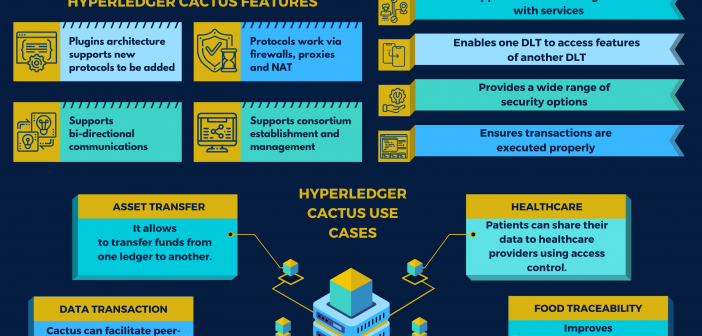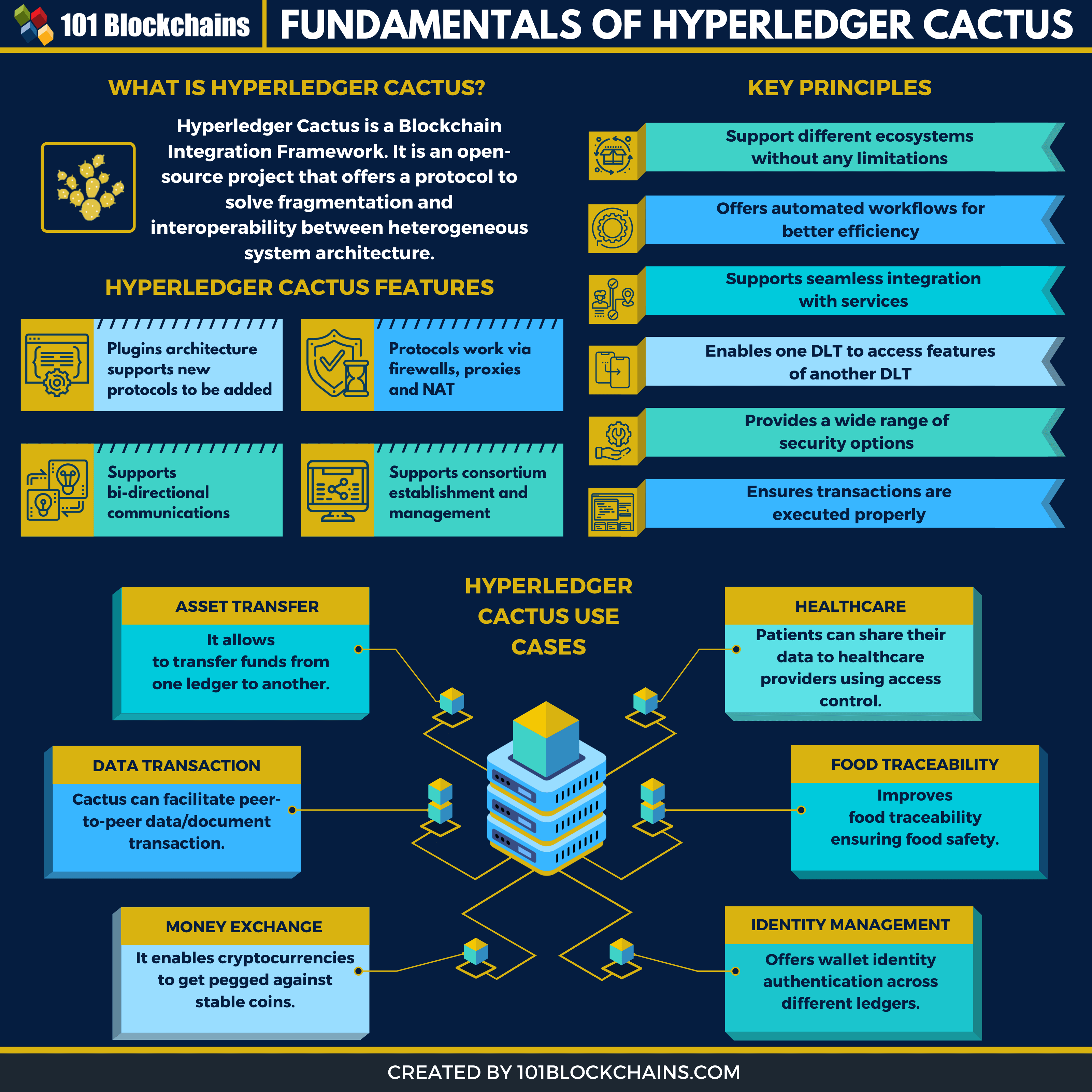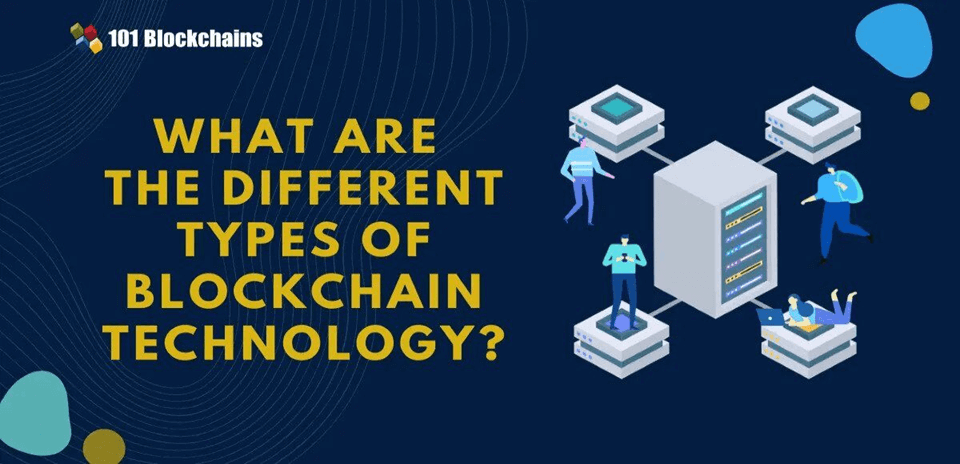Learn how blockchain truly works, master key definitions, and uncover what makes smart contracts so "smart." Dive into the fundamentals, gain valuable insights, and start your blockchain journey today!

- Reviews
101 Blockchains
- on May 18, 2020
Hyperledger Cactus: A New Hyperledger Framework
Recently, Hyperledger on their blog released new information about their new upcoming project Hyperledger Cactus.
The technical steering committee(TSC) finally approved the Hyperledger Cactus project after it stayed at work for the last six months. Initially, it was named as Blockchain Integration Framework, but later on, it changed to Hyperledger Cactus.
As you might already know, Hyperledger Cactus is an open-source project. The best terms that describe the project is the previous name for the project, i.e, Blockchain Integration Framework. The project is contributed by Fujitsu and Accenture. With its inclusion in the Hyperledger ecosystem, the project will now be managed according to the Hyperledger standards. The inclusion also made the TSC change its name to meet other Hyperledger projects and hence named it as “Hyperledger Cactus”
Note: This is not a Hyperledger Cactus Tutorial
Enroll Now: Getting Started with Hyperledger Fabric Course
What Is Hyperledger Cactus and Why Do We need it?
The Hyperledger project brings in a new focus on bringing blockchain technology to everyone. Right now, there are multiple projects that are working towards improving blockchain technology. However, they are fragmented and can actually slow down mass blockchain adoption among businesses and end-users.
The Hyperledger Cactus, also known as, Blockchain Integration Framework, is a protocol that aims to solve the fragmentation problem or at least aims to solve it with the help of heterogeneous system architecture.
There is a surge in enterprise blockchains and businesses adopting them. This means that there is a need for interoperability between the different implementations. The interaction can be between different industries utilizing enterprise blockchain technology or platforms optimized for their needs.
Their problem is to solve the interoperability problem and Hyperledger Cactus can be used to solve the problem. This way data can be shared among different systems without the need to create custom solutions for each type of infrastructure out there.
One good example is the supply chain. In a supply chain, there is a need for goods to move through different blockchain networks. This means that the data needs to be transferred from one network to another by keeping the information intact. Another use case is the transfer of tokenized digital money from one network to another.
To get a better understanding, let’s go through the Hyperledger Cactus use cases below.
Hyperledger Cactus Use Cases
The best possible way to understand Hyperledger Cactus is to go through its use cases.
Ethereum to Quorum Asset Transfer
One of the best use cases of Hyperledger Cactus is to offer value transfer between two different blockchain ledger technologies. For example, a user can have assets stored in Ethereum ledger. But now, he wants to exchange it for assets on the Quorum ledger. In general circumstances without the exchanger solution, the user needs to sell his Ethereum assets and then buy the Quorum assets using the money. But, that’s not possible for all types of assets.
To solve that particular issue, Hyperledger Cactus can offer Escrowed Asset Transfer social interaction. This interaction is important as it will give the user the flexibility to choose the blockchain ledger of his choice.
In this Hyperledger Cactus use case, the user once he transfers the assets from Ethereum will lose it from there. However, the asset will now be available on the Quorum ledger. Also, to make it work, the ledgers need to be provisioned and the exchanger should have its identities established before the exchange takes place.
Escrow Sale of Data for Coins
Hyperledger Cactus can also facilitate the escrowed sale of data for coins. By this, it means that it can offer a peer to peer exchange between two users using escrow between two different exchange or ledger systems.
The data that is shared between the users can be anything including an ad-tech database, machine learning model, digitized art, or so on!
One user who has the data initiates the transactions. Both the data and the funds go through the Hyperledger Cactus transaction using escrow. The transaction is done through an atomic swap, ensuring that both the parties’ interests are protected all the time.
To make all of this work, both parties need to share critical information including delivery addresses, escrow providers that they trust, and the current type.
Money Exchange
Hyperledger Cactus is also effective when it comes to pegging stable coins against other cryptocurrencies. In this use case, one user can actually implement and use Hyperledger Cactus to set an environment and use the necessary plugins to make the ledger work for token minting, transactions, and burning.
This use case is best described as a software implementation project where an established coin can use pegging to stable coin as a way to win the trust of the user. It is common for users to not trust coins that are not backed. The implementation can help those users to buy the coin when pegged against Bitcoin or USD.
Healthcare Data Share With Access Control
Another popular use case for Hyperledger Cactus is healthcare. The healthcare industry has been struggling with data sharing. The use of blockchain technology, however, enables them to share data among themselves. However, the use of different blockchain technology means the need for proper data exchange and interoperability.
Hyperledger Cactus can help solve the problem with the help of peer to peer data sharing social interaction. The patient benefits from this interaction too. They can decide if they want the healthcare provider to store the patient data including their medical history. The healthcare provider can ask for permission from the patient and once the permission is granted, the patient data is now stored based on the privacy features/ access control set by the user.
This also means that the user is in control of the data that is shared among different health providers as they have set access control themselves. The success of the case depends on how blockchain technology works. The cryptographic proof will ensure that no breach is done by any of the health providers when it comes to storing and sharing patient’s data.
Food Traceability Integration
Blockchain technology has made progress when it comes to food integration. IBM Food Trust is one of those projects that want to transform the food ecosystem by providing a smarter, safer, and sustainable environment.
Hyperledger Cactus can complement the IBM food trust by providing a means of the software implementation project. In this use case, the most beneficial end user is the consumer as he can evaluate the food in a physical store by querying the application that keeps traces of the food. Once he is sure about the food and its origin, he can make the purchase with full peace of mind.
The organizations handling the food can better interact with each other by ensuring that separate services/products can still synchronize and verify the origin of the food products sold at retail outlets. This means that the food manufacturer can share the information with other players in the food chain without the need to create a separate solution for it as it can be solved by Cactus. The retailer needs to integrate Cactus as an architectural component and provide an interface to the consumer to trace food during the supply chain.
Identity Management: End User Wallet Authorization and Authentication
The last Hyperledger Cactus example use case that we are going to discuss is the Wallet Authorization and Authentication.
This particular use case is all about giving the user the ability to manage and interact with wallets across different permissionless and permissioned ledgers. In simple words, the end-user will now be able to connect to different permissionless or permissioned networks through a single interface.
Hyperledger Cactus vs Fabric
If you follow the Hyperledger ecosystem, then you would know about Hyperledger Fabric. It is one of the most popular Hyperledger frameworks out there. There is no doubt that Cactus is new, but it is not there to change the blockchain technology landscape, but to better shape it for the currently existing solutions such as Fabric.
Hyperledger Fabric is a full-fledged framework that gives developers the ability to create solutions or applications with the help of modular architecture.
In essence, Hyperdeger Fabric is a framework and Cactus is a protocol that lets different ledger systems to connect and exchange information better.
Want to know more about them? Then check out Hyperledger Tutorial: The Ultimate Guide. We will soon cover the Hyperledger Cactus tutorial.
Hyperledger Cactus Principles
In this section, we are the core principles of Hyperledger Cactus. These principles govern the Hyperledger Cactus project.
Wide Support
The project wants to interconnect different ecosystems regardless of the limitations that the technology possesses.
Plugins Architecture
Cactus provides seamless integration to the services around itself. In this way, it wants to ensure that it really provides interoperability and minimizes opinionated integration. Moreover, they will also work with PRs and feedback to ensure that the Hyperledger Cactus code is lifted into plugins. Finally, they also want to ensure that adding future protocols and use cases are as seamless as possible.
No Double Spending
Another principle of Hyperledger Cactus is to prevent double-spending across different ecosystems at any given time.
DLT Feature Inclusivity
Distributed ledger technologies have their own architecture. This means that each DLT has features that are either partially or completely not available from other DLTs.
Hyperledger Cactus wants to ensure a design that makes it possible for those unique features to be accessible when Cactus accesses a DLT.
Low Impact
Hyperledger Cactus don’t want to redefine the ecosystem but want to make sure that there is interoperability among them. This low prevalence will ensure that the trust model, governance, and workflows are maintained in the respective ecosystem. The protocol handshake that takes place between the ecosystem needs to make sure that there the incompatibilities are shared upfront so that there is a way for the user to know about it. The user can then decide if he/she wants to proceed with the transactions.
Transparency
There will be complete transparency when it comes to global and local transfer implications. Also, Hyperledger Cactus will ensure that any errors are properly communicated to participants and that too in a timely fashion. The communication should also be done with evidence that can be used to either rectify the problem or notify the user.
Automated Workflows
The workflows between the ecosystem can be automatically designed to work. It will ensure quick execution.
Highest Security
Hyperledger Cactus will provide a wide range of secure options which will only be strictly opt-in with no option to opt-out.
Transaction Protocol Negotiations
There will be a handshake mechanism for participants. The handshake mechanism should have protocols to ensure that the transaction is executed properly.
Hyperledger Cactus Feature Requirement
Apart from the principles, the Hyperledger Cactus also offers some key features that we will discuss below.
New Protocol Integration: Cactus will ensure that there is always a way to add new protocols to the plugin’s architecture. This will empower the communication and let them propose, test, and develop implementations without any restrictions or limitations.
NAT/Firewall/Proxy Compatibility: It will let protocols work via NAT, firewalls, and proxies.
Bi-directional Communications Layer: Support for the bi-directional communication channel with or without the use of firewalls, proxy and NAT.
Consortium Management: Cactus will come with support for consortium management. This means that the cooperating entities can create consortiums and help the operation of the Cactus cluster by contributing network resources or hardware. The Cactus cluster is composed of API servers, validator nodes, and so on.
The consortium is focused on how to operate the cluster and ensure that it is free from any bugs.
Hyperledger Cactus Architecture
The Hyperledger Cactus architecture consists of key components as below:
- Interworking patterns
- Interworking architecture
- Technical architecture
- Transaction protocol specification
- Plugin architecture
All these are beyond the scope of the article so we will cover them in the Hyperledger Cactus architecture that we will cover soon! We will cover all of these stuff in the Hyperledger Cactus tutorial in our future articles as well.
Conclusion
This leads us to the end of the Hyperledger Cactus article. Here we tried to see what the new Hyperledger framework has to offer. The use cases are a good way to understand where Cactus can fit in.
So, what do you think about Hyperledger Cactus? Comment below and let us know.





